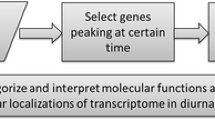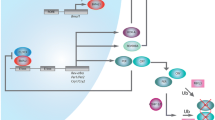Abstract
Molecular circadian oscillators have recently been identified in heart and many other peripheral organs; however, little is known about the physiologic significance of circadian gene cycling in the periphery. While general temporal profiles of gene expression in the heart have been described under constant lighting conditions, patterns under normal day/night conditions may be distinctly different. To understand how gene expression contributes to cardiac function, especially in human beings, it is crucial to examine these patterns in 24-h light and dark environments. High-density oligonucleotide microarrays were used to assess myocardial expression of 12,488 murine genes at 3-h intervals under the normal conditions of light and dark cycling. Variation in genetic activity was considerable, as 1,634 genes (~13% of genes analyzed) exhibited statistically significant changes across the 24-h cycle. Some genes exhibited rhythmic expression, others showed abrupt change at light-to-dark and dark-to-light transitions. Importantly, genes that exhibited significant cycling rhythms mapped to key biological pathways, including for example cardiac cellular growth and remodeling, as well as transcription, translation, mitochondrial respiration, and signaling pathways. Gene expression in the heart is remarkably different in the day versus the night. Some gene cycling may be driven by the central circadian pacemaker, while other changes appear to be responses to light and dark. This has important implications regarding our understanding of how the molecular physiology of the heart is controlled, including temporal patterns of organ growth, renewal, and disease, comparative gene expression, and the most appropriate times for administration of therapy.




Similar content being viewed by others
References
Guo YF, Stein PK (2003) Circadian rhythm in the cardiovascular system. Chronocardiology 145:779–786
Muller JE, Tofler GH, Stone PH (1989) Circadian variation and triggers of onset of acute cardiovascular disease. Circulation 79:733–743
Young ME, Razeghi P, Cedars AM, Guthrie PH, Taegtmeyer H (2001) Intrinsic diurnal variations in cardiac metabolism and contractile function. Circ Res 89:1199–1208
Charloux A, Gronfier C, Lonsdorfer-Wolf E, Piquard F, Brandenberger G (1999) Aldosterone release during the sleep-wake cycle in humans. Am J Physiol 276:E43–49
Haus E, Nicolau G, Lakatua DJ, Sackett-Lundeen L, Petrescu E (1989) Circadian rhythm parameters of endocrine functions in elderly subjects during the seventh to the ninth decade of life. Chronobiologia 16:331–352
Brzezinski A (1997) Melatonin in humans. N Engl J Med 336:186–195
Storch KF, Lipan O, Leykin I, Viswanathan N, Davis FC, Wong WH, Weitz CJ (2002) Extensive and divergent circadian gene expression in liver and heart. Nature 417:78–83
Anisimov SV, Boheler KP, Anisimov VN (2002) Microarray technology in studying the effect of melatonin on gene expression in the mouse heart. Dokl Biol Sci 383:90–95
Ueda HR, Matsumoto A, Kawamura M, Iino M, Tanimura T, Hashimoto S (2002) Genome-wide transcriptional orchestration of circadian rhythms in Drosophila. J Biol Chem 277:14048–14052
Ceriani MF, Hogenesch JB, Yanovsky M, Panda S, Straume M, Kay SA (2002) Genome-wide expression analysis in Drosophila reveals genes controlling circadian behavior. J Neurosci 22:9305–9319
Ueda HR, Chen W, Adachi A, Wakamatsu H, Hayashi S, Takasugi T, Nagano M, Nakahama KI, Suzuki Y, Sugano S, Iino M, Shigeyoshi Y, Hashimoto S (2002) A transcription factor response element for gene expression during circadian night. Nature 418:534–539
Penev PD, Kolker DE, Zee PC, Turek FW (1998) Chronic circadian desynchronization decreases the survival of animals with cardiomyopathic heart disease. Am J Physiol 275:H2334–2337
Furlan R, Barbic F, Piazza S, Tinelli M, Seghizzi P, Malliani A (2000) Modifications of cardiac autonomic profile associated with a shift schedule of work. Circulation 102:1912–1916
Reppert SM, Weaver DR (2002) Coordination of circadian timing in mammals. Nature 418:935–941.
Young ME, Razeghi P, Taegtmeyer H (2001) Clock genes in the heart. Characterization and attenuation with hypertrophy. Circ Res 88:1142–1150
Yamashita T, Sekiguchi A, Iwasaki YK, Sagara K, Iinuma H, Hatano S, Fu LT, Watanabe H (2003) Circadian variation of cardiac K+ channel gene expression. Circulation 107:1917–1922
Naito Y, Tsujino T, Fujioka Y, Ohyanagi M, Iwasaki T (2002) Augmented diurnal variations of the cardiac rennin-angiotensin system in hypertensive rats. Hypertension 40:827–833
Panda S, Antoch MP, Miller BH, Su AI, Schook AB, Straume M, Schultz PG, Kay SA, Takahashi JS, Hogenesch JB (2002) Coordinated transcription of key pathways in the mouse by the circadian clock. Cell 109:307–320
Harmer SL, Hogenesch JB, Straume M, Chang HS, Han B, Zhu T, Wang X, Kreps JA, Kay SA (2000) Orchestrated transcription of key pathways in Arabidopsis by the circadian clock. Science 290:2110–2113
Apte SS, Olsen BR, Murphy G (1995) The gene structure of tissue inhibitor of metalloproteinases (TIMP)-3 and its inhibitory activities define the distinct TIMP gene family. J Biol Chem 270:14313–14318
Spinale FG (2002) Matrix metalloproteinases. Regulation and dysregulation in the failing heart. Circ Res 90:520–530
Wei P, Zhao YG, Zhuang L, Ruben S, Sang QX (2001) Expression and enzymatic activity of human disintegrin and metalloproteinase ADAM19/Meltrin Beta. Biochem Biophys Res Commun 280:744–755
Stanton LW, Garrard LJ, Damm D, Garraick BL, Lam A, Kapoun AM, Zheng Q, Protter AA, Schreiner GF, White RT (2000) Altered patterns of gene expression in response to myocardial infarction. Circ Res 86:939–945
Taylor LA, Carthy CM, Yang D, Saad K, Wong D, Schreiner G, Stanton LW, McManus BM (2000) Host gene regulation during coxsackievirus B3 infection in mice: assessment by microarrays. Circ Res 87:328–334
Tan FL, Moravec CS, Li J, Apperson-Hansen C, McCarthy PM, Young JB, Bond M (2002) The gene expression fingerprint of human heart failure. Proc Natl Acad Sci USA 99:11387–11392
Morgan TO, Brunner HR, Aubert JF, Wang Q, Griffiths C, Delbridge L (2000) Cardiac hypertrophy depends upon sleep blood pressure: a study in rats. J Hypertens 18:445–451
Acknowledgements
We thank A. Dupuis for consulting on statistical analyses, E. Cuckerman for technical assistance, and D. Black and A. Wagner for graphics assistance. We are grateful for the support of the A. Ephriam and Shirley Diamond Cardiomyopathy Research Fund, and a grant from the Heart and Stroke Foundation of Ontario (T4479). D.D.B. acknowledges support from the Natural Science and Engineering Research Council of Canada. P.L. is Polo Chair of the Heart and Stroke Foundation of Ontario. M.S. acknowledges support from the University of Virginia for both the Center for Biomathematical Technology and the Center for Biological Timing, as well as NSF, NIH, and NSBRI.
Author information
Authors and Affiliations
Corresponding author
Additional information
T. Martino and S. Arab contributed equally to this study
Electronic Supplementary Material
Rights and permissions
About this article
Cite this article
Martino, T., Arab, S., Straume, M. et al. Day/night rhythms in gene expression of the normal murine heart. J Mol Med 82, 256–264 (2004). https://doi.org/10.1007/s00109-003-0520-1
Received:
Accepted:
Published:
Issue Date:
DOI: https://doi.org/10.1007/s00109-003-0520-1




